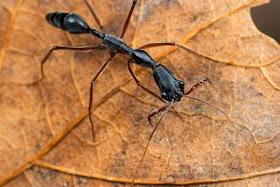There’s an invasive species conquering new territory in the southeastern United States. It has gnarly jaws, a formidable sting, and the ability to launch itself into the air like a bottle rocket. These insects are known as trap-jaw ants, and they could be heading to a backyard near you.
Most trap-jaw ants belong to the genus Odontomachus, named for their mandibles, or mouthparts, which are capable of opening 180 degrees.
“They look like little hammerhead sharks walking around,” said D. Magdalena Sorger.
Sorger has been studying these curious insects as part of her PhD research at North Carolina State University. She published a review of the trap-ant species living in the United States with co-authors Joe MacGown, Brendon Boudinot, and Mark Deyrup in the May issue of Zootaxa.
When Ants Go Marching
There are four species of trap-jaw ants native to the United States. Sorger and her co-authors were interested in the spread of an invasive and particularly aggressive species from South America called Odontomachus haematodus.
This species has apparently been living in North America for about 50 years, but new surveys show O. haematodus is on the move and now common across numerous states on the Gulf Coast.
What changed over the last half century? Sorger said the population might have been building up before it spread out, or perhaps changes to the climate provided conditions better suited to the species’ success.
Meet the Neighbors
You might think an ant with massive mandibles would be clumsy, but scientists have found that the trap-jaw ant’s bite is among the fastest known movements in the animal kingdom.
“Trap-jaw ants have little sensory hairs on the inside of their jaws,” said Sheila Patek, a biologist who studies the evolutionary mechanics of movements at Duke University. Patek explained that these hairs are linked directly to the muscles that hold the jaw open. “So they can fire those latch muscles even faster than their brain can process.”
Jumping Ants? Sort Of.
Grabbing and stunning prey aren’t the only things those mandibles are good for. When threatened, trap-jaw ants fire their bite against the ground with so much force that it hurls them into the air like popcorn out of a frying pan.
When a whole army of trap-jaw ants does this at once, Patek says it can get a little scary.
“The next thing you know you have this ant flying through the air that you can’t even see, it’s moving so fast, with a big stinger on the end of its abdomen,” she said. “It is really nerve-racking working with them.”
Source: Here


No comments:
Post a Comment